I. Introduction:
When we cross borders between countries, we immediately identify differences in language, currency, habits, etc. In fact each
country has its own culture and traditions. But working in different companies across the globe, employees, managers, and
directors seem to amalgamate in roles with very similar characters. How can we justify these behavioral patterns, considering
the above? Why have I seen the same miseries and human conflicts emerge in so many different companies in such diverse countries
and socio-cultural contexts?
On the surface, our world has never seemed smaller. Instant communications, the rise of multinational corporations, and the
interconnectedness of national economies would suggest that barriers are being broken down. Globalization, the media, and the
power of international brands are all homogenizing the world.
For organizations from small businesses to global corporations, change poses a huge challenge. It means that people, the most
important resource within the organization, must be flexible and imaginative. They must have substance, they must be Masters.
Those who are self-centred, rigid, and exclusionary, and see life as a sort of game of smoke and mirrors - the Players - cannot
adapt to change. Like dinosaurs, they are destined for extinction. And the companies they control will inevitably become
unprofitable and will collapse. The distinction between the Masters and the Players is so great that there is really no
conversation between the two groups. A healthy organization is filled with Masters. In such an organization, your work reflects
your passion. None of the inherent structural problems that led up to the 2008 economic crash have been addressed. We are fast
approaching a tipping point after which we risk a total meltdown.
Can Players create wealth? Yes, they can create extraordinary wealth. We see it in the corporate empires that exist in the
industrialized West, Japan, and Korea. We see it in the powerful government bureaucracies in Russia, China, Egypt, and North Korea. But
as we have seen over and over again throughout history, even vast wealth can be fleeting. Huge corporations implode overnight, like
Enron did. Others, like General Motors, slowly decay and become arthritic, ultimately needing life-saving intervention.
Cesare Borgia vs. Federico da Montefeltro:
The Game, as designed by the Players, has persisted for centuries. And always there have been, and still are, the Masters - living
parallel lives, seemingly in a different universe. In the sixteenth century, Niccolò Machiavelli wrote The Prince; Machiavelli's
treatise teaches us how to play the game of power and prestige. Machiavelli's basic premise is that the Game is an immutable fact
of life, no different from the laws of survival in the jungle. The goal is to win the game by any means necessary. When we think
of Machiavelli's Renaissance prince - the consummate Player, respecting no moral boundaries - it is Cesare Borgia who comes to mind. In
today's political and corporate environment, we see many would-be Cesare Borgias. They succeed on Wall Street, in the boardroom,
and in politics. Just as sharks only occasionally attack other sharks, Players only occasionally prey upon each other. For any
Player to succeed - from Cesare Borgia to Bernie Madoff to the dynasties of executives and managers at General Motors for forty
years - wealth must be extracted not from other Players but from the numberless Troopers who aspire to become
Players believe in the Game and are willing to sacrifice for a seat at the table. Troopers become winners often enough to keep the
vision of success alive in the heart of every other Trooper. Likewise, for every Trooper who breaks through the barrier and ascends
to the exalted realms of the Players, thousands more ride the subway to work every day. When an organization is controlled by
Players and populated by hapless Troopers, we may call it Mesozoic, in honor of the dinosaurs, who were unable to adapt to changing
conditions, and were doomed to extinction. The Mesozoic universe of Players and Troopers may be depressing and grim, but there is
hope: Players do not have a monopoly on success.
Around the same period in history as Cesare Borgia, only a few miles away in the province of Marche, a very different kind of
prince lived and thrived - Federico da Montefeltro, Duke of Urbino. Federico, as a mercenary captain, is without equal in military
history. Victorious in all of his military campaigns, he was never defeated in battle - a particularly notable achievement when we
consider the fact that these were internecine conflicts with mercenaries employed on both sides. How was Federico able to succeed
without falling into the moral tar pit of the Player? He was what we call a Master - an actor whose skills are in fact far beyond
that of the Player. The Master operates within a moral universe, builds wealth with integrity, enjoys the support of the community,
and leaves a positive legacy.
How is it that Machiavelli, who must have had intimate knowledge of the exploits of the
Duke of Urbino, finds no place to mention him in The Prince? Why is it that Cesare Borgia - the Player - is known by so many, yet
Federico da Montefeltro - the Master - is known by so few?
The aim of this program is to cast some light on how we came to be where we are, and the changes that we need to make to our prevailing
approach to leadership and organization moving forward. And unlike The Prince, the contention is that there is a way in which one
can play - and win - the Game without selling one's soul. Players live day to day and see only as far as the next quarter, and the
rigid Circle Square Pattern that they inhabit can, like the dinosaurs, be wiped out by the unrelenting pace of change. We have seen
it happen, and unless we take action it will happen over and over again. Instead of aspiring to become Players so that we can take
our place in their petrified hierarchy, we become Masters, able to turn the Game back on itself.
The Ideal Organization:
Change is natural. Change is good. Change is necessary. In the absence of intervening factors, change is the prevailing condition.
Therefore, when the situation is stagnant, we have to look for a hidden dynamic that is preserving the status quo. This is
the Circle Square Pattern. The present paradigm of management, which itself lies within yet another paradigm based on a "control
pressure" model. Control is exercised through compliance, and the pressure through accountability. The archetype of structure that
supports this is the classical vertical hierarchy.
Structure is meant to elevate us, to free us, not to confine us. In our world it has been subverted and has become the yoke to
lock not just our bodies in place, but our minds and souls as well. The Player-and-Trooper culture promotes a robotic mindset in
which all are just going through the motions, with their minds parked elsewhere. The problem arises when they have to deal with
new and changing conditions - which these days take place on a daily basis. They simply cannot cope! Having done their jobs
mechanically for so long, when the situation varies, the employee simply has no idea of how to accommodate the new conditions. In
the past, the focus was on producing more; now it must be on producing intelligently.
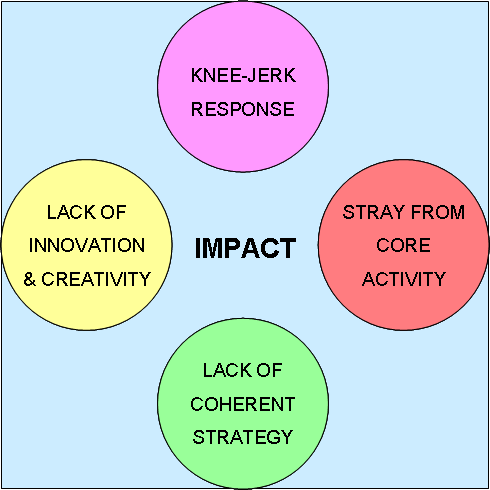
The knee-jerk response to the limitations of the prevailing paradigm is to seek some utopia in which there is a complete absence
of conflict and tension. Not only is this not desirable, it is impossible - since any movement requires a degree of tension. The
challenge is in transmuting this from a negative, destructive pressure to a creative force: dynamic tension. The objective of the
new Relationship paradigm will be to maintain this tension, not allowing it to dissipate into groupthink and consensus on the one
hand, or into a kind of directionless cacophony of dissonant voices on the other - each demanding to be heard but loth to listen
to the other.
Shifting from one paradigm to another is not as simple as ascertaining where we are, identifying where we wish to go, and plotting
the straightest course between the two points. Instead it requires us to go back and start from scratch. This translates to returning
to the core principles from whence the present paradigm came, and then deriving an entirely new iteration attuned to the modern
context.
In fact the ideal environment should not even be thought of an organization, but as a harmonization - an environment where there is
indeed place for all, even the Players, but now the orchestra is playing a single tune.
II. The Three Social Orientations:
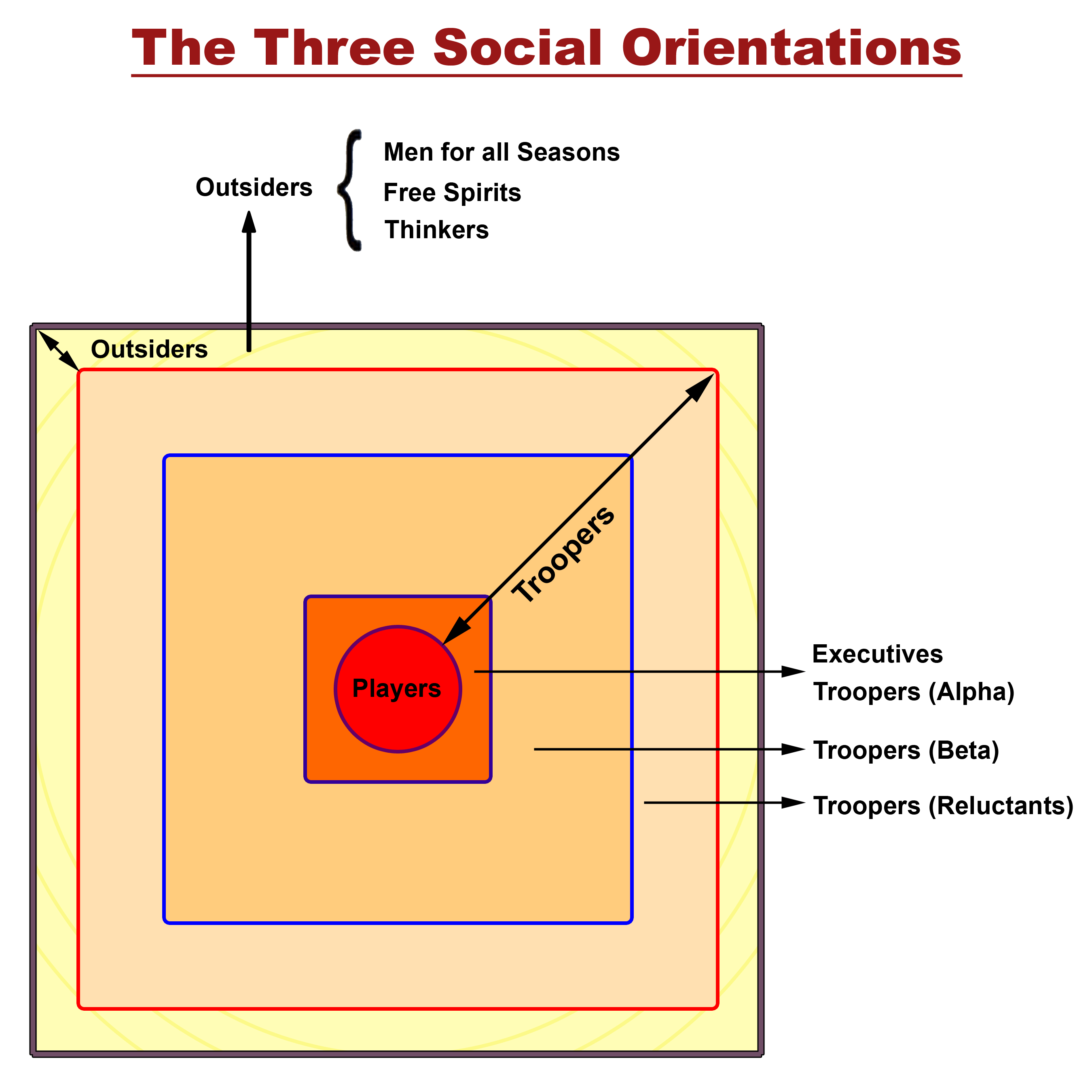
Walk into any local café or pub anywhere in the world, and look around the room. More likely than not, there will be one table
around which you will find a group of individuals, probably longtime friends, sitting together. If we were to examine this group
more closely we would notice that all those at the table fall into one of three distinct types with respect to their social
orientation - their attitude towards the group: those who influence the group, the Players; those who conform to the group, the
Troopers; and finally those who are out of sync with the group, the Outsiders.
Players:
The word Player is heavily loaded. It can be used in number of contexts. The first is related to team or sport. Next is within the
context of the theater stage. Also, there is the player of people - the manipulator. All of the interpretations mentioned above
apply to the Player in this model.
The Player looks at life as a game. Their approach to any situation is zero-sum: either win or lose. Win-win is not an option.
This describes their pattern of movement on the strategic level. On the tactical level, the theater metaphor is the one that best
applies. Consummate actors, players carefully orchestrate their presentation, leaving nothing to chance. They diligently assess
the situation and determine the role that would optimize their chances of achieving the greatest degree of status, money and
recognition with the least effort. They then proceed to ensure that in every aspect of their appearance, demeanor, and
speech (tone and content), they remain true to the character they have contrived. Finally, down on the level of the social playing
field - meetings and compositions, Players are expert at managing the perceptions and actions of those around them. Their favored
modus operandi is misdirection - presenting one message to the public while beneath the surface pursuing quite a different agenda.
Characteristically, their "talk" is win-win, while their "walk" is zero-sum.
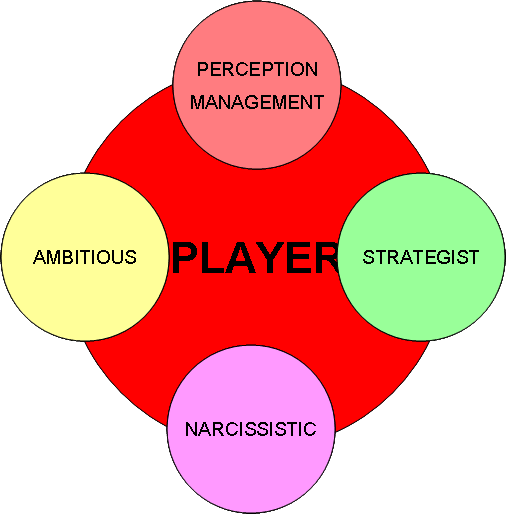
Of the three functional areas within the organization - finance, operations, and marketing, it is in the latter, marketing, that
we find the overwhelming majority of Players. Their strategic approach to human interaction, coupled with their ability to gauge
the deeper motivations and pretensions of those around them, while being able to present a perfectly tuned message that incorporates
all of this knowledge, makes Players superlative salespeople.
Troopers:
The Trooper represents the "everyman" in this model. The overwhelming majority of the group will fall into this category. The defining
characteristic of the Trooper is a need for security. In Maslow's hierarchy this represents the most primal need forming the base of
the pyramid - the need for food and shelter.
Within the context of the organization this security translates to the assurance that their position is secure, the company likely to
stay afloat. For the Trooper, clearly defined rules and a system of reward and punishment that is unambiguous and fairly applied are
essential.
Beneath the surface, the Players are fairly uniform. This is less true of the Troopers. Fill the outer presentation is highly conformist;
beneath the surface they can exhibit a wide range of personality styles. Broadly speaking, Troopers can be split into three subcategories:
Alpha, beta, and reluctant.
At the top we have the Alphas. They are characteristically ambitious, hardworking, highly competent, honest, and with a low tolerance for
ambiguity. They can be thought of as the officer class. So long as the Alpha is confident that, provided they stay within the rules and
apply themselves fully, advancement is assured, they can be counted upon to devote themselves to the organization heart, body, and soul.
Below the Alphas we have the Betas. These are those who "go long to get along". For the Beta, job security is everything. They will endure
tedium, hardship, even abuse, so long as they know they will be taken care of.
Finally, we have the Reluctant Trooper. This category describes those who are not naturally inclined to cling to the group, but their need
for security still held outweighs their personal drive for individual expression and autonomy.
Outsiders:
Nicolai walked into the café. Up till now we had only communicated over the phone, with our conversations often extending for hours. The
topics either centered on my model, or his algorithm, peppered with political and philosophical commentary.
I recognized him immediately: the unkempt hair, the discordant arrangement of clothing that looked as if they had been pulled out of a
cupboard in the dark, the distracted, yet intense expression on his face - all gave him away.
I stood up and waved. His face lit up; a smile twinkled in his eyes, suddenly softening his weathered Slavic features, giving them a
child-like expression. At first, the conversation was a bit stilted as each of us got our bearings. After the halting start, the exchange
took wing. Someone watching from another table would have seen two middle aged men, excitedly gesticulating, passionately pressing their
points, trying to make the other really "get" the essence that lay behind their thoughts. Each ready with their response before the other
had a chance to finish their diatribe.
Nikolai is an Outsider. In the world of Players with their smooth, even delivery, careful selection of topics, designer clothes, and
impeccable grooming, he finds himself completely lost. Small talk is simply beyond the capacity of the Outsider. The clever banter,
namedropping, references to the last golf game you had or restaurant you tried, makes no sense to him. When Nicolai speaks, it is to
convey a point. When he finds your arguments compelling, he will happily say so. If he does not, which is the more likely the case,
Nicolai will let you know ??bluntly! The weather may change, fashions may change, the times may change, but Nikolai remains steadfastly
the same!
One of the great hidden costs of the Player culture, with its obsession with impressions and perceptions, is the brain drain it creates. The
Nicolais of this world ??brilliant, original, and authentic - are among its first casualties. They are the Mozarts whom the Salieris must
discredit and marginalize, lest their own mediocrity and perfidy be brought to light.
In the short term this does not pose much of a problem. The Outsider is easily replaced by someone else, far less brilliant, marginally
competent, but infinitely more compliant. The problem arises when there is a crisis, or a major shift in the business playing field. In
these cases it is not enough to follow prescribed practice as stated in the company manual, splice a few sound-bites together to make a
strategy, or bamboozle the market with a few marketing tricks. In such times, real substantive thinking is required. These episodes were
the rare exception in the past; today they are the rule. Now, when we need them the most, the thinkers are nowhere to be found, having been
removed from the playing field long ago.
Let us examine each type of Outsider and explore why they might be perceived as a threat to the Players.
The Thinker:
Firstly, we have the creative thinkers. This refers to abstract thinkers such as mathematicians and philosophers. These thinkers have the
ability to penetrate beyond the surface to divine the hidden patterns that lie beneath. For them the world of theoretical first principles
is far more real than the surface reality we encounter in our daily lives. The thinkers typically present as introverted, distracted,
absent minded, or overly intense. They talk about ideas and concepts rather than facts or people. They are unable to engage in small talk
of any kind, severely handicapping them at cocktail parties or around the water cooler at work.
Such thinkers can be of use to the Players in solving specific problems; however, the Players will never let them anywhere near the inner
circle where the real power resides.
Often they will be well paid, but the clear understanding at all times is that the Players are in charge. If this condition is violated
(the thinker wishing to be an equal partner), the Players will simply get rid of them, to the point of cutting off their nose to spite
their face.
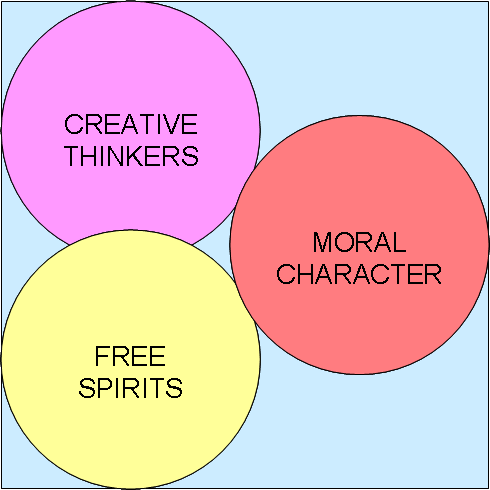
The Free Spirit:
The second category of Outsider is the maverick, the free spirit. Free spirits are by their very nature non-compliant. As such they are
totally unsuitable to the square box structure that sustains the Player culture. In the large organizational environment they are typically
subversive, irreverent, and contemptuous of dogma and authority. The free spirit is typically the first casualty of the rigid control
structure. Such people are regarded as being unmanageable. Typically, when they are let go, the charges levied against them are that they
are difficult to work with, not team players, or simply do not "fit in."
The Man for all Seasons:
Even though most of us would like to believe our moral conduct as being guided by an inner compass, in the vast majority of cases this is
not true. The real driver is the conduct of those around us. If they are noble, we, as the everyman, will be noble. If they are corrupt,
we are likely to follow suit. However, there are those characters who are truly driven by an inner compass. We only know this because r
egardless of how much they deviate from the groupthink, and how precarious their position becomes, they hold steadfastly to their beliefs.
Some are natural heroes, such as Thomas Moore, as depicted in the film A Man For All Seasons. However there are those who are reluctant
heroes, such as the protagonist of Graham Greene's The Power and the Glory. They might be indulgent characters, often exhibiting great
weakness in their day to day life, yet when it comes to the crunch there is something that prevents them from drinking the Kool-Aid, from
buying in.
The Master:
The path of the Outsider is the 'road less traveled'. Not fitting in, it is difficult for the Outsider to find their place in the game of
life. Many fall by the wayside - succumbing to eccentricity on the one side, and despair on the other. However, those few who are able to
stay the course, weather all the trials and tribulations that fate has thrust their way, and retain their sanity, humanity, and sense of
humor, become Masters. Through all that they have endured, the Masters have developed a level of empathy and wisdom that is not accessible
to either the Troopers or the Players.
Though the Masters are few in number, they can be found in every organization. They rarely occupy positions of power or status; they tend
to be buried deep within the rank and file, closer to the bottom of the ladder than the top. Though almost invariably overlooked by
management, they are loved and respected by those around them, who seek them out for both solace and council.
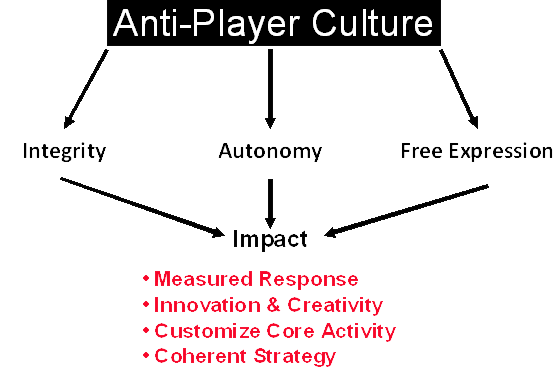
As a final note on the Outsiders it bears mentioning that there is no hierarchy in terms of degree of outsider-ness with respect to the
categories presented above. Also, the final category, the Master, has an equal chance of belonging to any one of the categories of Outsiders.
Summary:
Each of the categories of Outsider shares a common trait ??an insight into a hidden order.
Each of the four experiences this differently. For the thinker it is the essential blueprint that lies embedded inside the structure of all
things. The free spirit experiences it as the genie of inspiration. Meanwhile, the individual of substance is guided by a moral rudder that supersedes
logic ??an innate ability to distinguish between right and wrong. This shared connection to a higher calling at once sets the Outsiders apart
from others and places them beyond the influence of the Players. This poses a problem for the Players on two levels:
1. The Players by nature need absolute control. The Outsiders are by definition wild cards; so long as they are at large, the Players' control
is not absolute and their hold over the environment is not fully secured. This then places the Players in an untenable position.
2. The Outsiders are typically oblivious to the enmity that the Players feel towards them. As they are focused on something other than the
social reality around them, the notion that they should be perceived as a threat by anyone would strike them as absurd. Also, the Players'
preoccupation with their hidden game is unfathomable to the Outsiders. From the Outsiders' perspective, to invest so much time and energy in
such a mundane pursuit as trying to manipulate and control those around them is simply unimaginable. This makes the Outsider easy prey for the
Player, who is often able to finesse them and get them out the door with the Outsider having no idea how they have been played, or even that they
have been played at all.
There is yet one more very practical reason for the Players to conspire against the Masters. The corporate cult is the glue that holds the Circle
Square Pattern in place. The distinguishing characteristic of a cult, that which makes it a cult in the first place, is the uniformity of thinking
and behavior among its members. This single-mindedness is a type of trance ??a robotic state of awareness, somewhere between sleep and consciousness.
This trance aspect is at once the trump and the Achilles' heel of the Players. On the one hand, once this trance is firmly in place, all the
Players need do is let it run. With a cult in place, the company runs on autopilot, and the situation takes care of itself. On the other hand, in
its absence, sooner or later those in the company would surely come to the realization that they have been played. Therefore, it is absolutely
imperative from the
Players' perspective that this trance be maintained, regardless of the impact on the bottom line as a result of lack of market feedback, unresponsiveness, or brain drain.
For the corporate cult to be effective, all within the company must buy in. Even if just one individual in the crowd resists accepting the shared
reality prescribed by the Players, there is the risk that this doubt could spread like a virus through the organization. The Outsiders, as we've
described earlier, are unlikely to fully buy in by their very nature, as they are too firmly grounded in their own reality. This is not
willfulness on their part, so much as a matter of basic temperament. The Master is the silent witness, the one in the crowd who knows the
Players for what they are ??nothing more than bombastic impostors. As such, the Master is, by their very existence, a mortal threat to the
dominance of the Players.
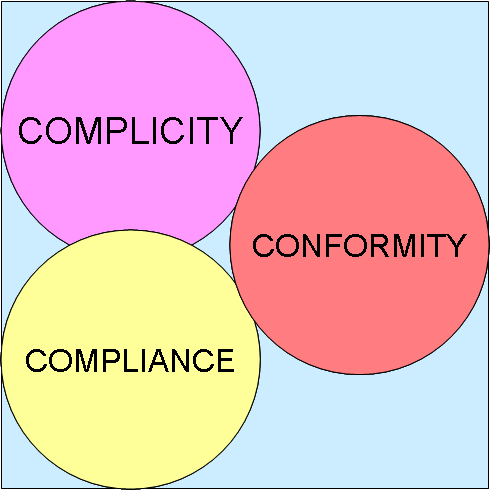
Therefore, it is not just out of cupidity but from practical necessity that the Players must move the Masters as far away from the line of power
as possible. In situations where a
Master possesses technical expertise, or a creative talent that is indispensable to the firm, they will be retained. However, even in such cases
they are tucked away in some specialty department where their exposure to the main line staff can be kept to a minimum.
III. The Circle Square Pattern (CSP)
Once the population of Players in the upper ranks reaches critical mass, a tipping point is reached after which the organization becomes subsumed
by a Player culture. The Circle Square Pattern (CSP) is the generic structure created by the Player culture. It is a natural extension of two
traits of the narcissistic personality style characteristic of the Players:
- Entitlement - Holding themselves above accountability
- Control - Holding the rank and file fully accountable
The three elements that support the structure are:
1. An elitist inner circle.
2. A rigid control structure.
3. A dogmatic corporate culture.
The Circle:
The senior managers, being Players, have a natural tendency towards an autocratic, aristocratic management style. They tend to distance themselves
from the day to day running of the company, preferring instead to devote their energy towards "strategy." In order to secure their position at the
top and avoid scrutiny, the Players need to minimize transparency. This is done in four ways:
Political Correctness:
The environment is split into two. Most in the company take the stated values of the organization at face value and attempt to conform to them.
Meanwhile, those in the inner circle pay lip service to these values while pursuing their own agenda.
Physical Separation:
This two-caste effect is also achieved via physical segregation. The executive offices are typically physically located either well away from the
administrative and operational facilities, or housed in an altogether different location. There is no "open door" policy in the
Player-driven organization, and access to executives is tightly controlled by those in their entourage. Even written communication must pass
through channels prescribed by organizational protocol.
Restricted Access to Information:
There is limited transparency around all of the key decisions made in the company. A general secretiveness pervades the organization, with a
reluctance to disclose information of any kind. The typical justification for this opaqueness is protecting the company's proprietary interests
by ensuring that sensitive information does not fall into the hands of outside parties.
Skewing the Executive Selection Process:
The only way to preserve this two-tiered game is to have restricted access to the inner circle. This is achieved by promoting only those who are
likely to fit in to the upper ranks.
This will usually entail stacking the deck in the informal selection criteria to ensure that only the right sort of candidate is put forward.
The best way to ensure loyalty of those in the Circle is through complicity. Some form of malfeasance is the typical mechanism used to achieve
this result. These days this is done legally by manipulating the corporate governance system to yield consistently high bonuses to those in the
inner circle irrespective of the true economic performance of the firm. This acts as the glue that holds the group together. Should anyone suddenly
find their conscience, they will invariably discover that they are in too deep to blow the whistle.
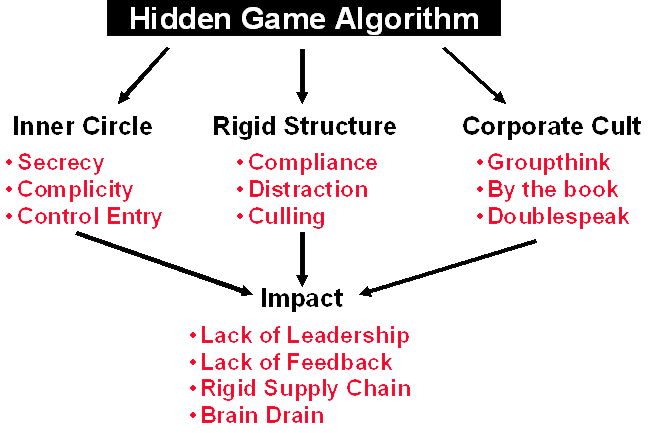
The Square:
The autocratic style of the Players creates a corporate governance system that is rigid, complex and dogmatic, and becoming increasingly so with
the passage of time. A heavy emphasis is placed on compliance and accountability, discouraging free-thinking and personal initiative in the process.
The organizational structure is left in place. On the surface, it looks the same and continues to direct traffic ??transactions and information ??
within the organization. However, the rules are subtly adapted in such a way that all are held strictly accountable through a highly defined chain
of command. Meanwhile, those in the inner circle are accountable to no one but themselves. Such a rigid, strict culture creates an atmosphere that
is tense and anxious. Fear and distrust now begin to permeate the organization, which psychologically destabilizes those within the ranks.
This process is insidious, its gradual onset making it imperceptible to most within the company.
In order for the culture to be fully effective, there needs to be unquestioning obedience. All must regard the rules and regulations as moral laws.
By extension, the company and the senior management must be seen as inherently moral. This explains why the Players go to such great lengths to
appear morally righteous and "nice." This is the true basis for political correctness ??the need to shroud their agenda with a mantle of propriety.
The Organizational Cult:
Over a century ago, the brilliant French philosopher and sociologist Gustave Le Bon in his book The Crowd described crowd psychology in exhaustive
detail. As Le Bon illustrated, once a group of individuals are transformed into a cohesive crowd ??be it a team, a panel of experts, a jury, or a
mob in the street ??they have become a single entity, thinking and acting with one mind and as one individual. Through the transformation of a
group of individuals within the company into a crowd, the CSP is now complete. It has now achieved the requisite structural integrity to assure
sustainability. The two elements ??the Circle and the Square ??are now tightly locked into place through their mutual interdependency.
Players need to close the Circle in order to conceal their shortcomings, as much as their agenda. The Square - the complex labyrinth of quasi-moral
dogma necessary to keep all in their places ??creates an atmosphere of anxiety and confusion, and directs attention away from those individuals,
far from being the best and brightest, who are running the company. Finally, the crowd effect has the impact of imprinting the Square on the
collective mind of the crowd. This means that the crowd polices itself, without any assistance from formal authority. It's an organization
effectively running on autopilot.
The Circle Square structure draws certain types of personalities towards it while repelling others. Those who are best suited to the kind of rigid,
linear approach that the Players have towards management are those Troopers who are compliant by nature, have a low tolerance for ambiguity,
and have a very strong need for order and authority in their world.
Meanwhile, certain other personality types ??those who find the conformity and politics oppressive ??will withdraw or be passed over for promotion.
These would include creative thinkers, free spirits, and those with strong, individualized moral convictions ??all those who march to a beat of a
different drummer. These are the potential Masters.
The corporate culture associated with this rigidity is a kind of Drone culture. This then sets the tone for the entire organization. This Drone
culture functions adequately in relatively static situations, however, once the environment starts to become more variable the
Troopers are simply not able to adapt to the new conditions. Their programming is directed at accommodating conditions in the past, not in the
future.
Within this culture, functional areas become progressively more specialized. Instead of integrating and synthesizing information from several
areas, these days many people's mental functioning is more akin to data processing. The result is that their ability to respond to the unforeseen
is severely restricted, their response being confined to a limited range of pre-programmed strategies. This makes for employees who may be highly
efficient in the classical sense, but are not particularly effective at getting the job done. In the past, the focus was upon producing more; now
it must be on producing intelligently.
TInevitable Decline:
Over time, the grandiosity of the Players grows, creating an increasing pressure on the company to expand its reach. This causes a series of
problems. Firstly, the impetus to expand puts pressure on the organization to grow in ways that stray from the core business, diluting its
competitive advantages. This then places additional stress on financial and operational controls, as well as on lines of communication within the
firm.
The inherent rigidity of the organization responds to this additional stress by becoming still more restrictive, which further aggravates the
problem by creating log jams which impede the transaction flow- the lifeblood of the organization.
This then feeds back into the system by creating further motivation to expand in order to balance itself. The removal of any lingering Masters
means that in times of crisis there are none on staff who are capable of really analyzing the problems, coming up with original and creative
solutions, or who have the strength of character to be the bearer of bad tidings and contradict the groupthink. This further limits the range
of movement open to senior management in dealing with situations as they arise. Not being up to the task, the Players have a natural tendency
to retreat further into their ivory towers, driving the downward spiral faster still.
The absence of any self-correcting mechanism that might counteract this tendency creates a momentum that is irreversible. Employees become
increasingly disillusioned with the tediousness of their work, the backstabbing politics, and the phlegmatic attitude of those at the top.
This translates to poor morale, the lowering of standards of quality and service, absenteeism, and high turnover. Ultimately it manifests in a
kind of "blowback" wherein employees become subversive and spiteful, leading to petty theft and even outright sabotage. The cumulative effect is
a downward spiral that is, like a vortex, drawing more and more resources into it, at an ever-increasing rate. The result is that by the time the
company does fail, which beyond a certain point becomes inevitable, it may take down partners and stakeholders with it.
Summary:
Take any piece of iron and leave it outside, exposed to the elements, and it will oxidize and produce rust. Over time the rust will spread and
penetrate the surface of the material, progressively eroding and ultimately compromising its structural integrity.
Similarly, the Circle Square Pattern is not a random configuration that happens from time to time under the presence of certain specialized
conditions. It is instead the path of least resistance for any organizational culture. In the absence of intervening factors, over the fullness
of time, it is the inevitable outcome.
These three elements - the formation of the closed inner clique (Circle), the rigid control structure (Square), and the corporate Drone culture
??represent a progression. Once all three elements are in place, the loop is closed and the company is locked into a certain set way of operating,
and a kind of groupthink begins to grip the organization, bringing with it conformity in thought and behavior. The organization is effectively on
autopilot, rigid and insular. It becomes a world unto itself.
IV. Transition
When we survey the world around there is one key attribute that immediately distinguishes nature from artifice. That attribute is grace. This
grace is reflected through an elegant fluency of motion, a harmonious balance of disparate elements. It has an infinite number of variations,
yet there is a certain subtle sameness that draws this infinite array of possibilities together. This grace is also the hallmark of excellence in
every endeavor.
Within the context of any action grace has two preconditions- those being alignment and flow. The only way that flow can be maintained is through
proper alignment of all of moving parts in the system. This applies equally to the movement of a racehorse, a car, and athlete, or a dancer. As
observed from this vantage point the impact of this skew towards the players, as expressed through the circle square pattern is the death of grace
within the organization. The objective of the transition is to restore the organization to a state of grace.
As both alignment and flow are innate qualities, the focus is not so much on enhancing them directly, as in removing the roadblocks that have
caused them to become impeded. This involves reversing a process that has caused the problem to rise in the first place.
In the normal course of events, the Players rise to dominate the group - subordinating the Trooper, and marginalizing the Outsider. At this
juncture, the reader is likely to conclude that the solution toward which I am driving involves reversing the skew, thereby giving the Outsider
the edge over the Player.
Such a resolution, even to the extent that it would be achievable, would be neither sustainable nor desirable. By advocating for the Outsider
and clipping the wings of the Player, we might, in the short run at least, increase innovativeness, and make the workplace into a much kinder and
saner place. However, it will remove the elements necessary for creative dynamic tension to be achieved and maintained. This is precisely the
problem that plagued communities such as the hippie communes of the 60s and many of the social experiments carried out in the New World by social
visionaries hoping to create Utopia. They relied heavily upon consensus and the innate goodness of each individual in the community, while
eschewing the discipline of commercial reality. The almost inevitable result was that the centrifugal force of individual expression overwhelmed
the gravitational force created by the need for common cause, the result being that the groups dissipated and dissolved over time.
The Players play a vital role in the optimal organization. They provide a restrictive opposing force that marshals the creative initiatives of
the Outsiders, securing the organization on the catwalk between inertia on the one hand, and chaos on the other. On the external front, they are
an invaluable asset in engaging with the various stakeholders - customers, bankers, regulatory bodies, competitors, and suppliers - all charter
members of the Player-driven paradigm that pervades commercial reality in any part of the world.
The objective then is to introduce a kind of wedge - a restrictive element that leaves the Players largely in place, while preventing them from
completely marginalizing the outsiders. The mechanics would include the following:
- Creation of a protective room wherein the Outsiders would be free to interact and contribute in ways consistent with their nature and temperament.
- The application of a proprietary diagnostic to the interaction of employees in both formal and informal group settings within the
organization, enabling the Outsiders to be picked out of the crowd.
- The next step will be to assemble the selection of Outsiders in a casual, informal setting outside the organization. A local pub or café can
serve admirably for this purpose.
- Once the group has assembled, the consultant's role will be to ensure that the flow of composition should be as easy and natural as possible.
The objective of this stage is to form the group organically to help the natural leaders, the Masters, to come to the fore.
- Now, once the group has formed, the focus shifts to generating a stream of actionable projects directed at improving the quantity and quality
of the transactional flow within the organization.


 BerlingHardy@gmail.com
BerlingHardy@gmail.com
 Bahman@Canaglobe.ca
Bahman@Canaglobe.ca